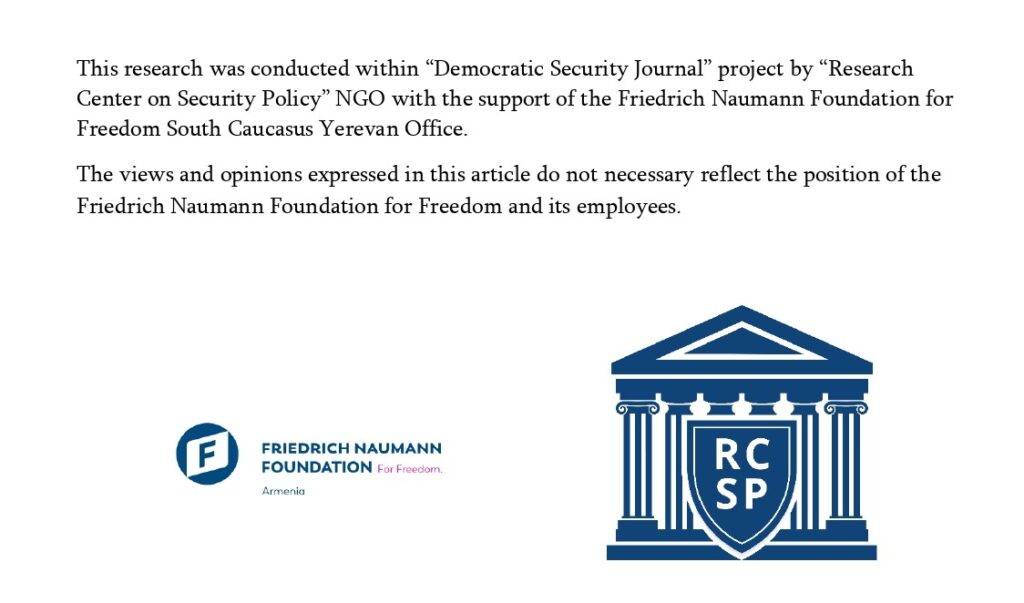Introduction
The social and political developments in Armenia in 2018 marked the beginning of the country’s democratic transformation. This qualitative shift in the political regime was also[i] recognized by several international organizations specializing in democracy research.
At the same time, a global democratic decline has been observed, with 19 out of the 20 largest and most influential G20 countries experiencing[ii] negative democratic trends. Similarly, since 2018, democracy indices in Armenia have indicated stagnation and regression in the pace of democratic development.
This article aims to explore the prospects of democracy in Armenia by identifying the internal and external factors influencing its trajectory.
Measurement of Democracy and the Reality in Armenia
Before examining the quality and prospects of democracy in Armenia, it is important to first define what is meant by democracy in this article. Given the diversity of theoretical approaches, this article adopts a definition of democracy that combines several perspectives.
Thus, democracy is understood as the presence of free and competitive elections, the guarantee and exercise of political and civil liberties, and the protection of fundamental rights. In this sense, the concept of democracy used in this article closely aligns with the definition provided by Freedom House’s Global Freedom index.
In democratic regimes, one of the key indicators of electoral integrity is the possibility of a change in power through elections. Moreover, for elections to be considered truly democratic, they must meet the following three criteria[iii]:
a) Ex ante uncertainty of election results
b) Ex post irreversibility of election results
c) Regularity
The evaluation of these criteria will allow for an analysis of political regime changes in Armenia and an assessment of its democratic development prospects.
The table below presents Armenia’s scores in Freedom House’s Global Freedom index from 2017 to 2024.
| Year | Political Rights Score (out of 40) | Political Rights Score (out of 40) | Political Rights |
| 2016 | 16 | 29 | 45 |
| 2017 | 15 | 30 | 45 |
| 2018 | 20 | 31 | 51 |
| 2019 | 21 | 32 | 53 |
| 2020 | 22 | 33 | 54 |
| 2021 | 23 | 32 | 55 |
| 2022 | 23 | 31 | 54 |
| 2023 | 23 | 31 | 54 |
From the data table, it is evident that there has been significant positive progress in the “political rights” component, whereas civil liberties have shown only minor improvements, despite having greater potential for development. Nevertheless, according to the Freedom House methodology, a score of 30 or higher in “civil liberties” and 20 or higher in “political rights” indicates the presence of electoral democracy in a given country. This means that following the 2018 revolution, an electoral democracy was established in Armenia; however, transitioning to a liberal democracy requires considerable effort.
Notably, the “political rights” component includes criteria related to electoral processes, political pluralism and participation, and government performance. Significant progress in recent years has been observed in the electoral process, which, to a certain extent, aligns with the principles of initial uncertainty (ex ante), subsequent immutability (ex post), and periodicity. Some reservations regarding this aspect will be discussed separately.
The “civil liberties” component encompasses criteria related to freedom of speech and conscience, freedom of assembly and association, the rule of law, and personal autonomy and rights. According to Freedom House assessments, Armenia particularly lags behind in the rule of law, specifically in judicial independence and fair trial standards.
Considering the post-revolutionary social and political developments, including the pandemic, war, the loss of Nagorno-Karabakh, and the displacement of Armenians, the following conclusions can be drawn: Armenia has managed to achieve a positive qualitative transformation of its political regime, particularly in terms of electoral competitiveness and the inclusiveness and diversity of the political landscape. However, post-election processes, especially at the local government level, remain problematic, as they allow central authorities to politically influence election outcomes.
Armenia has also maintained certain achievements in the realm of civil liberties and rights, but it must be acknowledged that no significant progress has been recorded since 2018. These achievements can primarily be attributed to objective realities—such as the spirit of the times (zeitgeist) and the country’s socio-economic development—rather than any specific political leadership or will. The best argument supporting this assertion is the negligible impact of power transitions on this indicator.
Prospects for the Development of Democracy in Armenia
Based on the current reality and data, it is essential to understand what prospects exist for the development of democracy in Armenia. To explore this issue, it is necessary to address several conceptual questions:
a) To what extent is regime change linear or, in other words, are there specific political and social factors that cause and lead to democracy through a cause-and-effect relationship?
b) Given Armenia’s objective economic, legal, and social institutions, is it not in a regime that corresponds to its status, meaning that Armenia’s democratic development requires a different socio-economic model?
c) To what extent is the quality of Armenia’s (and other small countries’) regime influenced by the external environment, including external shocks?
Before answering these questions, it is important to emphasize that there are no definitive answers to them, and they are largely dependent on the researcher’s perspective.
Regarding the linearity of democratic development, it must be argued that, although this process is influenced by objective structural data, it is absolutely not linear. Countries with similar socio-economic models and institutional environments may end up with different political regimes. The best example of this is Kyrgyzstan, which was once an electoral democracy. Now, it is a classical form of autocracy, with no medium-term prospects for democratic development. Therefore, the acquisition of electoral democracy does not, in a linear sense, lead to the consolidation of democracy over time.
For Armenia, and especially for civil society, this means that democratic issues and demands, which were on the agenda before 2018, must continue to remain on the agenda now. Moreover, the democratic regression is a detailed, gradual, and often unnoticed process[iv] that requires constant effort and work to counteract.
The logical continuation of the aforementioned is the discussion of the objective nature of the current regime. The competitive and participatory nature of the political system, as well as the certain level of rights and freedoms, even though they are the result of factors such as a growing economy (GDP per capita), large-scale capital outflows[v], and the fact that elites are not compelled to strongly oppose democratic demands[vi], still political factors play a significant role and weaken the argument for the regime’s objectivity in Armenia. It is important to emphasize that the connection between capital outflows and democratization pertains to the form and liquidity of assets held by the government and elites. In cases of liquid, exportable assets, elites are less likely to forcefully suppress democratic demands and are more inclined to make concessions.
Among the significant political factors in Armenia are the low public participation in political and electoral processes, leading to legitimacy issues, the near absence of an opposition based on democratic values, the intertwining of politics and money—especially oligarchic influence, and the lack of tested applications of checks and balances. In this context, the parliamentary elections of 2026 will be an institutional critical point. It is crucial not only to assess the results of the government but also those of the opposition with a democratic platform. This is because public indifference, even in the case of democratic elections and results, always poses a significant risk for a non-democratic change of power.
And let us turn to the external factor in the context of democratic development in Armenia.
It should first be noted that democratic, good governance reforms are an expensive process in terms of human, financial, and time resources. Therefore, for small countries with a scarcity of these resources, external support is crucial.
However, new trends in international relations, particularly the shift in the priorities of U.S. foreign policy, indicate that being democratic is no longer encouraged—at least in the context of U.S. support. This will significantly complicate the efforts of small countries to strengthen democracy, which may encounter and will encounter both internal and external obstacles. In the case of Armenia, the decrease in technical and political support for democracy from the U.S., and the impossibility of obtaining support of the same scale from the EU, will create a very vulnerable situation for democracy. The resilience of civil society, mentioned earlier, was largely based on external support. Additionally, a serious challenge for Armenia is the authoritarian environment in the region, where having weak internal legitimacy and replacing that legitimacy with external dependency becomes the main lever for influencing Armenia.
Conclusion
In summarizing the above, it is important to emphasize several observations and conclusions. Currently, the risks hindering democracy in Armenia are greater than the institutional resilience capacity of Armenia. However, this does not mean that these risks will materialize simultaneously. When risks materialize partially and at different times, Armenia’s institutional environment has sufficient capacity and capability to maintain the democratic order. Furthermore, it is important to note that the discussed risks are also subject to qualitative changes over time, becoming either less or more influential. However, it must be understood that, should these risks materialize, retrospectively, democracy in Armenia, as in Kyrgyzstan, might be seen not as a rule, but as an exception. Therefore, all internal and external actors interested in Armenia’s democratic future must make systematic and consistent efforts to manage the above-mentioned risks.
[i] https://freedomhouse.org/country/armenia/freedom-world/2019; https://www.v-dem.net/data_analysis/CountryGraph/
[ii] https://copese.org/wp-content/uploads/2020/11/Democratic-regression-in-comparative-perspective-scope-methods-and-causes.pdf
[iii] Alvarez, M., Cheibub, J. A., Limongi, F., & Przeworski, A. (1996). Classifying political regimes. Studies in comparative international development, 31, 3-36.
[iv] Levitsky, S., & Ziblatt, D. (2019). How democracies die. Crown.
[v] https://tradingeconomics.com/armenia/capital-flows
[vi] Boix, C. (2003). Democracy and redistribution. Cambridge University Press.
Photo by CNN
Tigran Mughnetsyan


